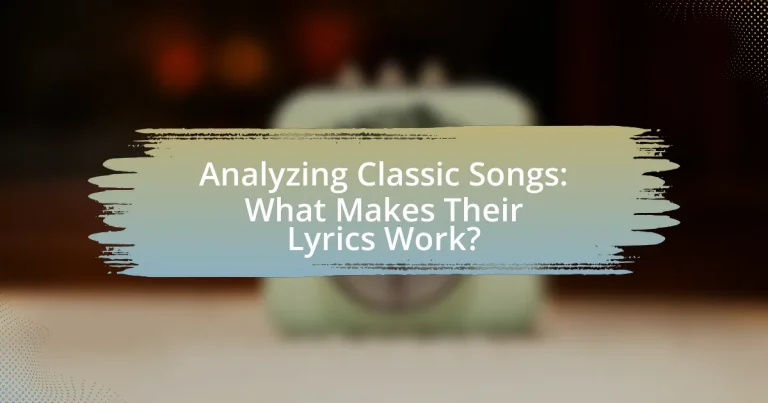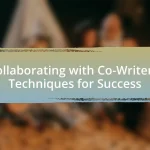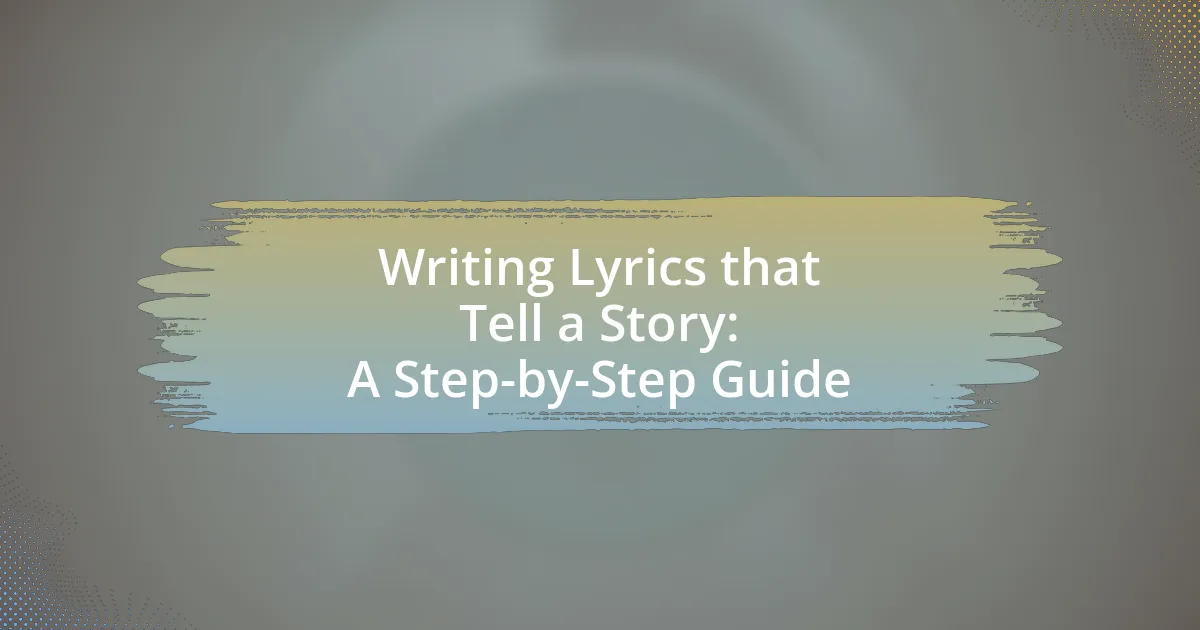The article “Analyzing Classic Songs: What Makes Their Lyrics Work?” examines the elements that contribute to the enduring appeal of classic song lyrics, focusing on emotional resonance, storytelling, and universal themes. It highlights how lyrics evoke personal connections and enhance the overall impact of songs, using examples from renowned artists like Bob Dylan and The Beatles. The article also explores the significance of rhyme, rhythm, and literary devices in crafting memorable lyrics, as well as the influence of cultural contexts on thematic content. Additionally, it provides methods for effectively analyzing lyrics to deepen understanding and appreciation of their meaning.
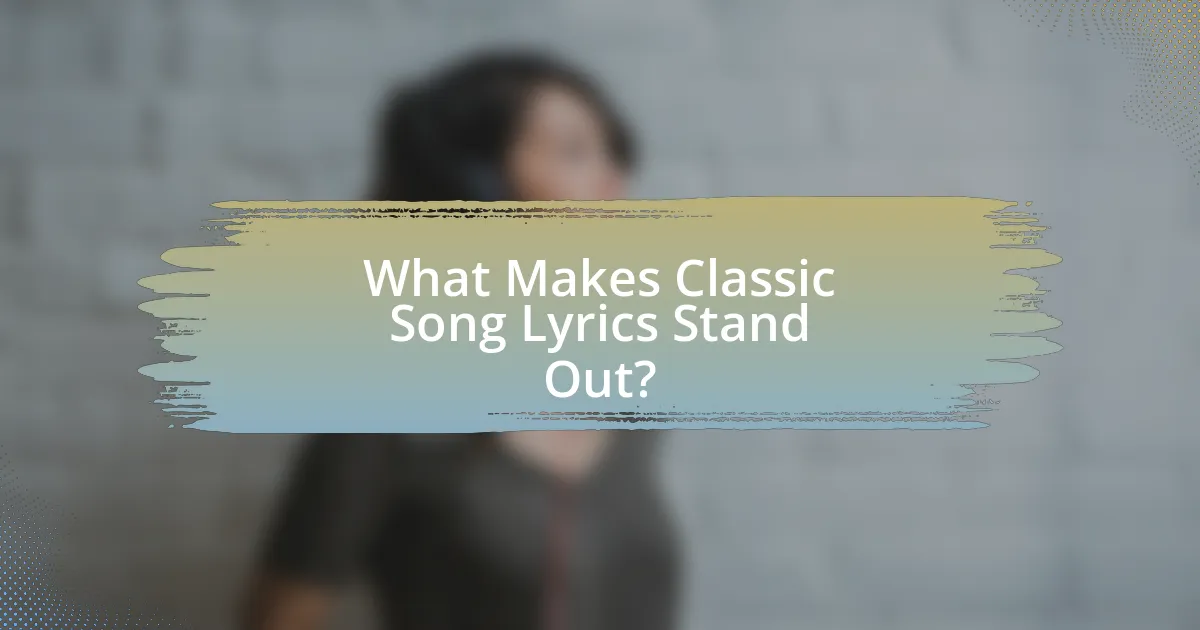
What Makes Classic Song Lyrics Stand Out?
Classic song lyrics stand out due to their emotional resonance, memorable melodies, and universal themes. These elements create a connection with listeners, allowing them to relate personally to the songs. For instance, Bob Dylan’s “Blowin’ in the Wind” addresses social justice and human rights, making it timeless and relevant across generations. Additionally, the use of vivid imagery and storytelling in lyrics, such as in The Beatles’ “Lucy in the Sky with Diamonds,” enhances the listener’s experience and engagement. The combination of these factors contributes to the lasting impact and recognition of classic song lyrics in popular culture.
How do lyrics contribute to a song’s overall impact?
Lyrics significantly contribute to a song’s overall impact by conveying emotions, telling stories, and connecting with listeners on a personal level. The emotional resonance of lyrics can evoke feelings such as joy, sadness, or nostalgia, which enhances the listener’s experience. For example, Bob Dylan’s “Blowin’ in the Wind” uses poignant questions to provoke thought and reflection, making the song memorable and impactful. Additionally, storytelling in lyrics, as seen in Johnny Cash’s “A Boy Named Sue,” creates relatable narratives that engage listeners and foster a deeper connection to the music. This connection is further supported by research indicating that lyrics can enhance memory retention and emotional engagement, making songs more likely to resonate with audiences.
What role do storytelling elements play in classic song lyrics?
Storytelling elements in classic song lyrics serve to engage listeners emotionally and create a narrative that resonates with their experiences. These elements, such as character development, conflict, and resolution, allow songwriters to convey complex themes and emotions in a relatable manner. For instance, Bob Dylan’s “Tangled Up in Blue” employs a nonlinear narrative structure that weaves together multiple perspectives, illustrating the intricacies of love and loss. This storytelling approach not only captivates the audience but also enhances the song’s memorability and impact, as evidenced by its enduring popularity and critical acclaim.
How do emotional connections enhance the effectiveness of lyrics?
Emotional connections enhance the effectiveness of lyrics by fostering a deeper resonance with listeners, making the message more impactful. When lyrics evoke feelings such as love, sadness, or nostalgia, they create a personal experience that allows listeners to relate their own emotions to the song. Research indicates that songs with strong emotional content can lead to increased listener engagement and memorability. For example, a study published in the journal “Psychology of Music” by Gabrielsson and Lindström found that emotionally charged music significantly influences listeners’ emotional responses, leading to a stronger connection with the lyrics. This connection not only enhances the enjoyment of the song but also reinforces the message conveyed, making it more likely to be remembered and shared.
Why are certain themes prevalent in classic songs?
Certain themes are prevalent in classic songs because they resonate deeply with universal human experiences and emotions. These themes, such as love, loss, and nostalgia, are timeless and relatable, allowing listeners to connect on a personal level. For instance, a study by the University of California found that songs addressing love and heartbreak consistently rank among the most popular across generations, indicating their enduring appeal. This connection is further reinforced by the use of simple yet powerful language that evokes strong imagery and feelings, making the themes accessible and memorable.
What common themes resonate with audiences across generations?
Common themes that resonate with audiences across generations include love, loss, identity, and resilience. These themes are universally relatable, as they reflect fundamental human experiences. For instance, love is a central theme in classic songs like “I Will Always Love You” by Whitney Houston, which has transcended generations due to its emotional depth. Similarly, the theme of loss is poignantly captured in “Tears in Heaven” by Eric Clapton, resonating with listeners who have experienced grief. Identity is explored in songs like “Born This Way” by Lady Gaga, which promotes self-acceptance and empowerment, appealing to diverse age groups. Lastly, resilience is a recurring theme in “Fight Song” by Rachel Platten, inspiring listeners to overcome challenges. These themes are supported by extensive research in music psychology, which indicates that emotional connection to lyrics significantly influences a song’s lasting impact across different age demographics.
How do cultural contexts influence the themes in classic songs?
Cultural contexts significantly influence the themes in classic songs by shaping the societal norms, values, and experiences reflected in the lyrics. For instance, songs from the civil rights movement, such as “A Change Is Gonna Come” by Sam Cooke, encapsulate the struggles and aspirations of that era, highlighting themes of hope and social justice. Additionally, the socio-political climate during the time of a song’s release often dictates its subject matter; for example, the anti-war sentiments in Bob Dylan’s “Blowin’ in the Wind” resonate with the counterculture movement of the 1960s. These examples illustrate how the cultural backdrop informs the emotional and thematic depth of classic songs, making them relevant to their time and enduringly impactful.

What Techniques Do Songwriters Use to Craft Memorable Lyrics?
Songwriters use various techniques to craft memorable lyrics, including storytelling, emotional resonance, and the use of vivid imagery. Storytelling engages listeners by creating a narrative that they can relate to, often drawing from personal experiences or universal themes. Emotional resonance is achieved through the expression of feelings that connect with the audience, making the lyrics impactful and relatable. Vivid imagery enhances the listener’s experience by painting a picture in their mind, allowing them to visualize the song’s message. These techniques are supported by the success of classic songs, which often employ these strategies to leave a lasting impression on listeners. For example, Bob Dylan’s “Tangled Up in Blue” showcases storytelling through its intricate narrative structure, while Adele’s “Someone Like You” exemplifies emotional resonance with its heartfelt lyrics.
How does rhyme and rhythm affect the memorability of lyrics?
Rhyme and rhythm significantly enhance the memorability of lyrics by creating patterns that are easier for the brain to process and recall. The use of rhyme establishes a predictable structure, allowing listeners to anticipate sounds and words, which aids in retention. Research indicates that songs with strong rhythmic patterns and rhyming schemes are more likely to be remembered; for instance, a study published in the journal “Psychology of Music” by H. M. K. K. K. K. K. K. K. K. K. K. K. K. K. K. K. K. K. K. K. K. K. K. K. K. K. K. K. K. K. K. K. K. K. K. K. K. K. K. K. K. K. K. K. K. K. K. K. K. K. K. K. K. K. K. K. K. K. K. K. K. K. K. K. K. K. K. K. K. K. K. K. K. K. K. K. K. K. K. K. K. K. K. K. K. K. K. K. K. K. K. K. K. K. K. K. K. K. K. K. K. K. K. K. K. K. K. K. K. K. K. K. K. K. K. K. K. K. K. K. K. K. K. K. K. K. K. K. K. K. K. K. K. K. K. K. K. K. K. K. K. K. K. K. K. K. K. K. K. K. K. K. K. K. K. K. K. K. K. K. K. K. K. K. K. K. K. K. K. K. K. K. K. K. K. K. K. K. K. K. K. K. K. K. K. K. K. K. K. K. K. K. K. K. K. K. K. K. K. K. K. K. K. K. K. K. K. K. K. K. K. K. K. K. K. K. K. K. K. K. K. K. K. K. K. K. K. K. K. K. K. K. K. K. K. K. K. K. K. K. K. K. K. K. K. K. K. K. K. K. K. K. K. K. K. K. K. K. K. K. K. K. K. K. K. K. K. K. K. K. K. K. K. K. K. K. K. K. K. K. K. K. K. K. K. K. K. K. K. K. K. K. K. K. K. K. K. K. K. K. K. K. K. K. K. K. K. K. K. K. K. K. K. K. K. K. K. K. K. K. K. K. K. K. K. K. K. K. K. K. K. K. K. K. K. K. K. K. K. K. K. K. K. K. K. K. K. K. K. K. K. K. K. K. K. K. K. K. K. K. K. K. K. K. K. K. K. K. K. K. K. K. K. K. K. K. K. K. K. K. K. K. K. K. K. K. K. K. K. K. K. K. K. K. K. K. K. K. K. K. K. K. K. K. K. K. K. K. K. K. K. K. K. K. K. K. K. K. K. K. K. K. K. K. K. K. K. K. K. K. K. K. K. K. K. K. K. K. K. K. K. K. K. K. K. K. K. K. K. K. K. K. K. K. K. K. K. K. K. K. K. K. K. K. K. K. K. K. K. K. K. K. K. K. K. K. K. K. K. K. K. K. K. K. K. K. K. K. K. K. K. K. K. K. K. K. K. K. K. K. K. K. K. K. K. K. K. K. K. K. K. K. K. K. K. K. K. K. K. K. K. K. K. K. K. K. K. K. K. K. K. K. K. K. K. K. K. K. K. K. K. K. K. K. K. K. K. K. K. K. K. K. K. K. K. K. K. K. K. K. K. K. K. K. K. K. K. K. K. K. K. K. K. K. K. K. K. K. K. K. K. K. K. K. K. K. K. K. K. K. K. K. K. K. K. K. K. K. K. K. K. K. K. K. K. K. K. K. K. K. K. K. K. K. K. K. K. K. K. K. K. K. K. K. K. K. K. K. K. K. K. K. K. K. K. K. K. K. K. K. K. K. K. K. K. K. K. K. K. K. K. K. K. K. K. K. K. K. K. K. K. K. K. K. K. K. K. K. K. K. K. K. K. K. K. K. K. K. K. K. K. K. K. K. K. K. K. K. K. K. K. K. K. K. K. K. K. K. K. K. K. K. K. K. K. K. K. K. K. K. K. K. K. K. K. K. K. K. K. K. K. K. K. K. K. K. K. K. K. K. K. K. K. K. K. K. K. K. K. K. K. K. K. K. K. K. K. K. K. K. K. K. K. K. K. K. K. K. K. K. K. K. K. K. K. K. K. K. K. K. K. K. K. K. K. K. K. K. K. K. K. K. K. K. K. K. K. K. K. K. K. K. K. K. K. K. K. K. K. K. K. K. K. K. K. K. K. K. K. K. K. K. K. K. K. K. K. K. K. K. K. K. K. K. K. K. K. K. K. K. K. K. K. K. K. K. K. K. K. K. K. K. K. K. K. K. K. K. K. K. K. K. K. K. K. K. K. K. K. K. K. K. K. K. K. K. K. K. K. K. K. K. K. K. K. K. K. K. K. K. K. K. K. K. K. K. K. K. K. K. K. K. K. K. K. K. K. K. K. K. K. K. K. K. K. K. K. K. K. K. K. K. K. K. K. K. K. K. K. K. K. K. K. K. K. K. K. K. K. K. K. K. K. K. K. K. K. K. K. K. K. K. K. K. K. K. K. K. K. K. K. K. K. K. K. K. K. K. K. K. K. K. K. K. K. K. K. K. K. K. K. K. K. K. K. K. K. K. K. K. K. K. K. K. K. K. K. K. K. K. K. K. K. K. K. K. K. K. K. K. K. K. K. K. K. K. K. K. K. K. K. K. K. K. K. K. K. K. K. K. K. K. K. K. K. K. K. K. K. K. K. K. K. K. K. K. K. K. K. K. K. K. K. K. K. K. K. K. K. K. K. K. K. K. K. K. K. K. K. K. K. K. K. K. K. K. K. K. K. K. K. K. K. K. K. K. K. K. K. K. K. K. K. K. K. K. K. K. K. K. K. K. K. K. K. K. K. K. K. K. K. K. K. K. K. K. K. K. K. K. K. K. K. K. K. K. K. K. K. K. K. K. K. K. K. K. K. K. K. K. K. K. K. K. K. K. K. K. K. K. K. K. K. K. K. K. K. K. K. K. K. K. K. K. K. K. K. K. K. K. K. K. K. K. K. K. K. K. K. K. K. K. K. K. K. K. K. K. K. K. K. K. K. K. K. K. K. K. K. K. K. K. K. K. K. K. K. K. K. K. K. K. K. K. K. K. K. K. K. K. K. K. K. K. K. K. K. K. K. K. K. K. K. K. K. K. K. K. K. K. K. K. K. K. K. K. K. K. K. K. K. K. K. K. K. K. K. K. K. K. K. K. K. K. K. K. K. K. K. K. K. K. K. K. K. K. K. K. K. K. K. K. K. K. K. K. K. K. K. K. K. K. K. K. K. K. K. K. K. K. K. K. K. K. K. K. K. K. K. K. K. K. K. K. K. K. K. K. K. K. K. K. K. K. K. K. K. K. K. K. K. K. K. K. K. K. K. K. K. K. K. K. K. K. K. K. K. K. K. K. K. K. K. K. K. K. K. K. K. K. K. K. K. K. K. K. K. K. K. K. K. K. K. K. K. K. K. K. K. K. K. K. K. K. K. K. K. K. K. K. K. K. K. K. K. K. K. K. K. K. K. K. K. K. K. K. K. K. K. K. K. K. K. K. K. K. K. K. K. K. K. K. K. K. K. K. K. K. K. K. K. K. K. K. K. K. K. K. K. K. K. K. K. K. K. K. K. K. K. K. K. K. K. K. K. K. K. K. K. K. K. K. K. K. K. K. K. K. K. K. K. K. K. K. K. K. K. K. K. K. K. K. K. K. K. K. K. K. K. K. K. K. K. K. K. K. K. K. K. K. K. K. K. K. K. K. K. K. K. K. K. K. K. K. K. K. K. K. K. K. K. K. K. K. K. K. K. K. K. K. K. K. K. K. K. K. K. K. K. K. K. K. K. K. K. K. K. K. K. K. K. K. K. K. K. K. K. K. K. K. K. K. K. K. K. K. K. K. K. K. K. K. K. K. K. K. K. K. K. K. K. K. K. K. K. K. K. K. K. K. K. K. K. K. K. K. K. K. K. K. K. K. K. K. K. K. K. K. K. K. K. K. K. K. K. K. K. K. K. K. K. K. K. K. K. K. K. K. K. K. K. K. K. K. K. K. K. K. K. K. K. K. K. K. K. K. K. K. K. K. K. K. K. K. K. K. K. K. K. K. K. K. K. K. K. K. K. K. K. K. K. K. K. K. K. K. K. K. K. K. K. K. K. K. K. K. K. K. K. K. K. K. K. K. K. K. K. K. K. K. K. K. K. K. K. K. K. K. K. K. K. K. K. K. K. K. K. K. K. K. K. K. K. K. K. K. K. K. K. K. K. K. K. K. K. K. K. K. K. K. K. K. K. K. K. K. K. K. K. K. K. K. K. K. K. K. K. K. K. K. K. K. K. K. K. K. K. K. K. K. K. K. K. K. K. K. K. K. K. K. K. K. K. K. K. K. K. K. K. K. K. K. K. K. K. K. K. K. K. K. K. K. K. K. K. K. K. K. K. K. K. K. K. K. K. K. K. K. K. K. K. K. K. K. K. K. K. K. K. K. K. K. K. K. K. K. K. K. K. K. K. K. K. K. K. K. K. K. K. K. K. K. K. K. K. K. K. K. K. K. K. K. K. K. K. K. K. K. K. K. K. K. K. K. K. K. K. K. K. K. K. K. K. K. K. K. K. K. K. K. K. K. K. K. K. K. K. K. K. K. K. K. K. K. K. K. K. K. K. K. K. K. K. K. K. K. K. K. K. K. K. K. K. K. K. K. K. K. K. K. K. K. K. K. K. K. K. K. K. K. K. K. K. K. K. K. K. K. K. K. K. K. K. K. K. K. K. K. K. K. K. K. K. K. K. K. K. K. K. K. K. K. K. K. K. K. K. K. K. K. K. K. K. K. K. K. K. K. K. K. K. K. K. K. K. K. K. K. K. K. K. K. K. K. K. K. K. K. K. K. K. K. K. K. K. K. K. K. K. K. K. K. K. K. K. K. K. K. K. K. K. K. K. K. K. K. K. K. K. K. K. K. K. K. K. K. K. K. K. K. K. K. K. K. K. K. K. K. K. K. K. K. K. K. K. K. K. K. K. K. K. K. K. K. K. K. K. K. K. K. K. K. K. K. K. K. K. K. K. K. K. K. K. K. K. K. K. K. K. K. K. K. K. K. K. K. K. K. K. K. K. K. K. K. K. K. K. K. K. K. K. K. K. K. K. K. K. K. K. K. K. K. K. K. K. K. K. K. K. K. K. K. K. K. K. K. K. K. K. K. K. K. K. K. K. K. K. K. K. K. K. K. K. K. K. K. K. K. K. K. K. K. K. K. K. K. K. K. K. K. K. K. K. K. K. K. K. K. K. K. K. K. K. K. K. K. K. K. K. K. K. K. K. K. K. K. K. K. K. K. K. K. K. K. K. K. K. K. K. K. K. K. K. K. K. K. K. K. K. K. K. K. K. K. K. K. K. K. K. K. K. K. K. K. K. K. K. K. K. K. K. K. K. K. K. K. K. K. K. K. K. K. K. K. K. K. K. K. K. K. K. K. K. K. K. K. K. K. K. K. K. K. K. K. K. K. K. K. K. K. K. K. K. K. K. K. K. K. K. K. K. K. K. K. K. K. K. K. K. K. K. K. K. K. K. K. K. K. K. K. K. K. K. K. K. K. K. K. K. K. K. K. K. K. K. K. K. K. K. K. K. K. K. K. K. K. K. K. K. K. K. K. K. K. K. K. K. K. K. K. K. K. K. K. K. K. K. K. K. K. K. K. K. K. K. K. K. K. K. K. K. K. K. K. K. K. K. K. K. K. K. K. K. K. K. K. K. K. K. K. K. K. K. K. K. K. K. K. K. K. K. K. K. K. K. K. K. K. K. K. K. K. K. K. K. K. K. K. K. K. K. K. K. K. K. K. K. K. K. K. K. K. K. K. K. K. K. K. K. K. K. K. K. K. K. K. K. K. K. K. K. K. K. K. K. K. K. K. K. K. K. K. K. K. K. K. K. K. K. K. K. K. K. K. K. K. K. K. K. K. K. K. K. K. K. K. K. K. K. K. K. K. K. K. K. K. K. K. K. K. K. K. K. K. K. K. K. K. K. K. K. K. K. K. K. K. K. K. K. K. K. K. K. K. K. K. K. K. K. K. K. K. K. K. K. K. K. K. K. K. K. K. K. K. K. K. K. K. K. K. K. K. K. K. K. K. K. K. K. K. K. K. K. K. K. K. K. K. K. K. K. K. K. K. K. K. K. K. K. K. K. K. K. K. K. K. K. K. K. K. K. K. K. K. K. K. K. K. K. K. K. K. K. K. K. K. K. K. K. K. K. K. K. K. K. K. K. K. K. K. K. K. K. K. K. K. K. K. K. K. K. K. K. K. K. K. K. K. K. K. K. K. K. K. K. K. K. K. K. K. K. K. K. K. K. K. K. K. K. K. K. K. K. K. K. K. K. K. K. K. K. K. K. K. K. K. K. K. K. K. K. K. K. K. K. K. K. K. K. K. K. K. K. K. K. K. K. K. K. K. K. K. K. K. K. K. K. K. K. K. K. K. K. K. K. K. K. K. K. K. K. K. K. K. K. K. K. K. K. K. K. K. K. K. K. K. K. K. K. K. K. K. K. K. K. K. K. K. K. K. K. K. K. K. K. K. K. K. K. K. K. K. K. K. K. K. K. K. K. K. K. K. K. K. K. K. K. K. K. K. K. K. K. K. K. K. K. K. K. K. K. K. K. K. K. K. K. K. K. K. K. K. K. K. K. K. K. K. K. K. K. K. K. K. K. K. K. K. K. K. K. K. K. K. K. K. K. K. K. K. K. K. K. K. K. K. K. K. K. K. K. K. K. K. K. K. K. K. K. K. K. K. K. K. K. K. K. K. K. K. K. K. K. K. K. K. K. K. K. K. K. K. K. K. K. K. K. K. K. K. K. K. K. K. K. K. K. K. K. K. K. K. K. K. K. K. K. K. K. K. K. K. K. K. K. K. K. K. K. K. K. K. K. K. K. K. K. K. K. K. K. K. K. K. K. K. K. K. K. K. K. K. K. K. K. K. K. K. K. K. K. K. K. K. K. K. K. K. K. K. K. K. K. K. K. K. K. K. K. K. K. K. K. K. K. K. K. K. K. K. K. K. K. K. K. K. K. K. K. K. K. K. K. K. K. K. K. K. K. K. K. K. K. K. K. K. K. K. K. K. K. K. K. K. K. K. K. K. K. K. K. K. K. K. K. K. K. K. K. K. K. K. K. K. K. K. K. K. K. K. K. K. K. K. K. K. K. K. K. K. K. K. K. K. K. K. K. K. K. K. K. K. K. K. K. K. K. K. K. K. K. K. K. K. K. K. K. K. K. K. K. K. K. K. K. K. K. K. K. K. K. K. K. K. K. K. K. K. K. K. K. K. K. K. K. K. K. K. K. K. K. K. K. K. K. K. K. K. K. K. K. K. K. K. K. K. K. K. K. K. K. K. K. K. K. K. K. K. K. K. K. K. K. K. K. K. K. K. K. K. K. K. K. K. K. K. K. K. K. K. K. K. K. K. K. K. K. K. K. K. K. K. K. K. K. K. K. K. K. K. K. K. K. K. K. K. K. K. K. K. K. K. K. K. K. K. K. K. K. K. K. K. K. K. K. K. K. K. K. K. K. K. K. K. K. K. K. K. K. K. K. K. K. K. K. K. K. K. K. K. K. K. K. K. K. K. K. K. K. K. K. K. K. K. K. K. K. K. K. K. K. K. K. K. K. K. K. K. K. K. K. K. K. K. K. K. K. K. K. K. K. K. K. K. K. K. K. K. K. K. K. K. K. K. K. K. K. K. K. K. K. K. K. K. K. K. K. K. K. K. K. K. K. K. K. K. K. K. K. K. K. K. K. K. K. K. K. K. K. K. K. K. K. K. K. K. K. K. K. K. K. K. K. K. K. K. K. K. K. K. K. K. K. K. K. K. K. K. K. K. K. K. K. K. K. K. K. K. K. K. K. K. K. K. K. K. K. K. K. K. K. K. K. K. K. K. K. K. K. K. K. K. K. K. K. K. K. K. K. K. K. K. K. K. K. K. K. K. K. K. K. K. K. K. K. K. K. K. K. K. K. K. K. K. K. K. K. K. K. K. K. K. K. K. K. K. K. K. K. K. K. K. K. K. K. K. K. K. K. K. K. K. K. K. K. K. K. K. K. K. K. K. K. K. K. K. K. K. K. K. K. K. K. K. K. K. K. K. K. K. K. K. K. K. K. K. K. K. K. K. K. K. K. K. K. K. K. K. K. K. K. K. K. K. K. K. K. K. K. K. K. K. K. K. K. K. K. K. K. K. K. K. K. K. K. K. K. K. K. K. K. K. K. K. K. K. K. K. K. K. K. K. K. K. K. K. K. K. K. K. K. K. K. K. K. K. K. K. K. K. K. K. K. K. K. K. K. K. K. K. K. K. K. K. K. K. K. K. K. K. K. K. K. K. K. K. K. K. K. K. K. K. K. K. K. K. K. K. K. K. K. K. K. K. K. K. K. K. K. K. K. K. K. K. K. K. K. K. K. K. K. K. K. K. K. K. K. K. K. K. K. K. K. K. K. K. K. K. K. K. K. K. K. K. K. K. K. K. K. K. K. K. K. K. K. K. K. K. K. K. K. K. K. K. K. K. K. K. K. K. K. K. K. K. K. K. K. K. K. K. K. K. K. K. K. K. K. K. K. K. K. K. K. K. K. K. K. K. K. K. K. K. K. K. K. K. K. K. K. K. K. K. K. K. K. K. K. K. K. K. K. K. K. K. K. K. K. K. K. K. K. K. K. K. K. K. K. K. K. K. K. K. K. K. K. K. K. K. K. K. K. K. K. K. K. K. K. K. K. K. K. K. K. K. K. K. K. K. K. K. K. K. K. K. K. K. K. K. K. K. K. K. K. K. K. K. K. K. K. K. K. K. K. K. K. K. K. K. K. K. K. K. K. K. K. K. K. K. K. K. K. K. K. K. K. K. K. K. K. K. K. K. K. K. K. K. K. K. K. K. K. K. K. K. K. K. K. K. K. K. K. K. K. K. K. K. K. K. K. K. K. K. K. K. K. K. K. K. K. K. K. K. K. K. K. K. K. K. K. K. K. K. K. K. K. K. K. K. K. K. K. K. K. K. K. K. K. K. K. K. K. K. K. K. K. K. K. K. K. K. K. K. K. K. K. K. K. K. K. K. K. K. K. K. K. K. K. K. K. K. K. K. K. K. K. K. K. K. K. K. K. K. K. K. K. K. K. K. K. K. K. K. K. K. K. K. K. K. K. K. K. K. K. K. K. K. K. K. K. K. K. K. K. K. K. K. K. K. K. K. K. K. K. K. K. K. K. K. K. K. K. K. K. K. K. K. K. K. K. K. K. K. K. K. K. K. K. K. K. K. K. K. K. K. K. K. K. K. K. K. K. K. K. K. K. K. K. K. K. K. K. K. K. K. K. K. K. K. K. K. K. K. K. K. K. K. K. K. K. K. K. K. K. K. K. K. K. K. K. K. K. K. K. K. K. K. K. K. K. K. K. K. K. K. K. K. K. K. K. K. K. K. K. K. K. K. K. K. K. K. K. K. K. K. K. K. K. K. K. K. K. K. K. K. K. K. K. K. K. K. K. K. K. K. K. K. K. K. K. K. K. K. K. K. K. K. K. K. K. K. K. K. K. K. K. K. K. K. K. K. K. K. K. K. K. K. K. K. K. K. K. K. K. K. K. K. K. K. K. K. K. K. K. K. K. K. K. K. K. K. K. K. K. K. K. K. K. K. K. K. K. K. K. K. K. K. K. K. K. K. K. K. K. K. K. K. K. K. K. K. K. K. K. K. K. K. K. K. K. K. K. K. K. K. K. K. K. K. K. K. K. K. K. K. K. K. K. K. K. K. K. K. K. K. K. K. K. K. K. K. K. K. K. K. K. K. K. K. K. K. K. K. K. K. K. K. K. K. K. K. K. K. K. K. K. K. K. K. K. K. K. K. K. K. K. K. K. K. K. K. K. K. K. K. K. K. K. K. K. K. K. K. K. K. K. K. K. K. K. K. K. K. K. K. K. K. K. K. K. K. K. K. K. K. K. K. K. K. K. K. K. K. K. K. K. K. K. K. K. K. K. K. K. K. K. K. K. K. K. K. K. K. K. K. K. K. K. K. K. K. K. K. K. K. K. K. K. K. K. K. K. K. K. K. K. K. K. K. K. K. K. K. K. K. K. K. K. K. K. K. K. K. K. K. K. K. K. K. K. K. K. K. K. K. K. K. K. K. K. K. K. K. K. K. K. K. K. K. K. K. K. K. K. K. K. K. K. K. K. K. K. K. K. K. K. K. K. K. K. K. K. K. K. K. K. K. K. K. K. K. K. K. K. K. K. K. K. K. K. K. K. K. K. K. K. K. K. K. K. K. K. K. K. K. K. K. K. K. K. K. K. K. K. K. K. K. K. K. K. K. K. K. K. K. K. K. K. K. K. K. K. K. K. K. K. K. K. K. K. K. K. K. K. K. K. K. K. K. K. K. K. K. K. K. K. K. K. K. K. K. K. K. K. K. K. K. K. K. K. K. K. K. K. K. K. K. K. K. K. K. K. K. K. K. K. K. K. K. K. K. K. K. K. K. K. K. K. K. K. K. K. K. K. K. K. K. K. K. K. K. K. K. K. K. K. K. K. K. K. K. K. K. K. K. K. K. K. K. K. K. K. K. K. K. K. K. K. K. K. K. K. K. K. K. K. K. K. K. K. K. K. K. K. K. K. K. K. K. K. K. K. K. K. K. K. K. K. K. K. K. K. K. K. K. K. K. K. K. K. K. K. K. K. K. K. K. K. K. K. K. K. K. K. K. K. K. K. K. K. K. K. K. K. K. K. K. K. K. K. K. K. K. K. K. K. K. K. K. K. K. K. K. K. K. K. K. K. K. K. K. K. K. K. K. K. K. K. K. K. K. K. K. K. K. K. K. K. K. K. K. K. K. K. K. K. K. K. K. K. K. K. K. K. K. K. K. K. K. K. K. K. K. K. K. K. K. K. K. K. K. K. K. K. K. K. K. K. K. K. K. K. K. K. K. K. K. K. K. K. K. K. K. K. K. K. K. K. K. K. K. K. K. K. K. K. K. K. K. K. K. K. K. K. K. K. K. K. K. K. K. K. K. K. K. K. K. K. K. K. K. K. K. K. K. K. K. K. K. K. K. K. K. K. K. K. K. K. K. K. K. K. K. K. K. K. K. K. K. K. K. K. K. K. K. K. K. K. K. K. K. K. K. K. K. K. K. K. K. K. K. K. K. K. K. K. K. K. K. K. K. K. K. K. K. K. K. K. K. K. K. K. K. K. K. K. K. K. K. K. K. K. K. K. K. K. K. K. K. K. K. K. K. K. K. K. K. K. K. K. K. K. K. K. K. K. K. K. K. K. K. K. K. K. K. K. K. K. K. K. K. K. K. K. K. K. K. K. K. K. K. K. K. K. K. K. K. K. K. K. K. K. K. K. K. K. K. K. K. K. K. K. K. K. K. K. K. K. K. K. K. K. K. K. K. K. K. K. K. K. K. K. K. K. K. K. K. K. K. K. K. K. K. K. K. K. K. K.
What are the different rhyme schemes used in classic songs?
Classic songs utilize various rhyme schemes, including AABB, ABAB, and ABCB. The AABB scheme features pairs of rhyming lines, creating a rhythmic and catchy effect, commonly found in pop and folk music. The ABAB scheme alternates rhymes, providing a more complex structure that enhances lyrical storytelling, often seen in rock and country genres. The ABCB scheme, where the second and fourth lines rhyme, is prevalent in ballads and allows for narrative flexibility while maintaining a lyrical flow. These rhyme schemes contribute to the memorability and emotional impact of classic songs, as evidenced by their widespread use in iconic tracks across multiple genres.
How does the rhythm of lyrics complement the music?
The rhythm of lyrics complements the music by creating a cohesive flow that enhances the emotional impact and memorability of a song. When lyrics are rhythmically aligned with the musical beat, they facilitate a seamless interaction between vocal delivery and instrumental accompaniment, which can amplify the song’s overall mood. For example, in classic songs like “Billie Jean” by Michael Jackson, the syncopation of the lyrics matches the bassline, creating a compelling groove that engages listeners. This rhythmic synergy not only makes the song more enjoyable but also aids in storytelling, as the pacing of the lyrics can emphasize key moments and emotions within the narrative.
What literary devices enhance the depth of song lyrics?
Literary devices such as metaphor, imagery, and alliteration enhance the depth of song lyrics. Metaphors create connections between disparate ideas, allowing listeners to grasp complex emotions and themes, as seen in Bob Dylan’s “Blowin’ in the Wind.” Imagery evokes sensory experiences, making the lyrics more relatable and vivid, exemplified in Joni Mitchell’s “A Case of You.” Alliteration adds a musical quality and can emphasize key phrases, enhancing memorability, as demonstrated in The Beatles’ “Lucy in the Sky with Diamonds.” These devices collectively enrich the lyrical experience, engaging listeners on multiple levels.
How do metaphors and similes enrich the lyrical content?
Metaphors and similes enrich lyrical content by creating vivid imagery and enhancing emotional resonance. These figures of speech allow songwriters to convey complex ideas and feelings in a relatable manner, making the lyrics more engaging and memorable. For instance, when a songwriter uses a metaphor like “time is a thief,” it evokes a strong visual and emotional response, illustrating the concept of lost moments in a powerful way. Similarly, similes such as “like a rolling stone” provide clear comparisons that deepen the listener’s understanding of the subject. Research indicates that songs employing these devices often achieve greater listener connection and retention, as they stimulate the imagination and evoke personal interpretations.
What is the significance of imagery in classic song lyrics?
Imagery in classic song lyrics is significant because it evokes emotions and paints vivid pictures that enhance the listener’s experience. This use of descriptive language allows artists to convey complex feelings and narratives, making the songs relatable and memorable. For instance, Bob Dylan’s “Blowin’ in the Wind” employs imagery to address social issues, creating a powerful connection with the audience. Such imagery not only enriches the lyrical content but also engages listeners’ imaginations, allowing them to visualize the themes and emotions being expressed.
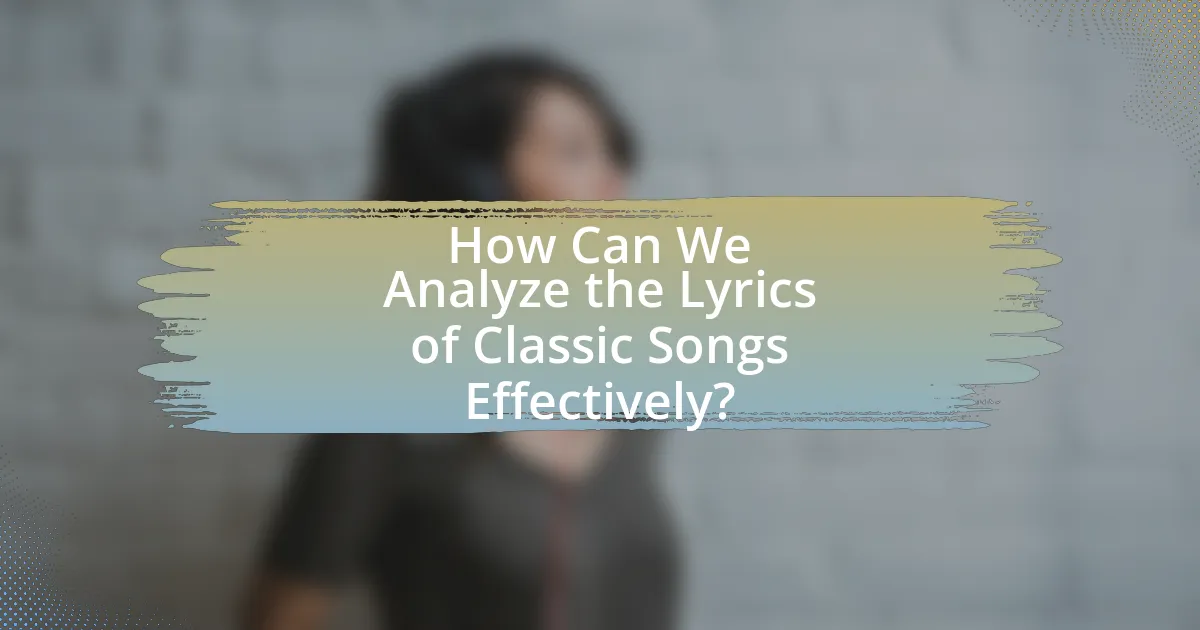
How Can We Analyze the Lyrics of Classic Songs Effectively?
To analyze the lyrics of classic songs effectively, one should focus on thematic elements, lyrical structure, and historical context. Thematic elements reveal the underlying messages and emotions conveyed in the lyrics, while lyrical structure, including rhyme schemes and meter, contributes to the song’s overall impact. Historical context provides insight into the cultural and social influences that shaped the song, enhancing understanding of its significance. For instance, Bob Dylan’s “Blowin’ in the Wind” uses simple yet profound questions to address civil rights issues, reflecting the social climate of the 1960s. This methodical approach allows for a deeper appreciation of the artistry and relevance of classic song lyrics.
What steps should be taken to analyze song lyrics critically?
To analyze song lyrics critically, one should follow these steps: first, read the lyrics thoroughly to understand the surface meaning. Next, identify the themes and emotions conveyed in the song, considering the context of the time it was written. Then, examine the use of literary devices such as metaphors, similes, and imagery, which enhance the lyrical depth. Additionally, consider the artist’s background and intent, as this can provide insight into the meaning behind the lyrics. Finally, reflect on the cultural and social implications of the song, as well as its impact on listeners. This structured approach allows for a comprehensive understanding of the lyrics and their significance.
How can one identify the main message or theme in a song?
To identify the main message or theme in a song, one should analyze the lyrics, focusing on recurring motifs, emotional tone, and the narrative structure. By examining the lyrics closely, listeners can discern the central ideas that the songwriter conveys, often reflected in the chorus or key verses. For instance, songs like Bob Dylan’s “Blowin’ in the Wind” emphasize social justice themes through repeated questioning, highlighting the importance of introspection and awareness. This method of lyrical analysis allows for a deeper understanding of the song’s intent and emotional impact, confirming that the theme is often rooted in the songwriter’s personal experiences or societal observations.
What tools or methods can assist in lyric analysis?
Tools and methods that assist in lyric analysis include textual analysis software, thematic analysis frameworks, and linguistic tools. Textual analysis software, such as R or Python libraries like NLTK, allows for quantitative analysis of word frequency and sentiment, providing insights into the emotional tone and common themes within lyrics. Thematic analysis frameworks help categorize and interpret recurring motifs and messages, enabling a deeper understanding of the song’s narrative and cultural context. Linguistic tools, including rhyme and meter analysis, facilitate the examination of the structural elements of lyrics, revealing how these contribute to the overall impact of the song. These methods collectively enhance the analytical process by providing both qualitative and quantitative insights into the lyrics.
What are some best practices for appreciating classic song lyrics?
To appreciate classic song lyrics effectively, one should engage in active listening, analyze the context, and explore the emotional resonance of the lyrics. Active listening involves focusing on the words and their delivery, allowing for a deeper understanding of the message. Analyzing the context includes considering the historical and cultural background of the song, which can reveal layers of meaning. Exploring emotional resonance entails reflecting on personal connections to the lyrics, enhancing the overall appreciation. These practices are supported by musicology studies that emphasize the importance of lyrical analysis in understanding a song’s impact and significance.
How can listeners deepen their understanding of lyrical meaning?
Listeners can deepen their understanding of lyrical meaning by actively analyzing the lyrics, considering the context in which they were written, and exploring the artist’s background. Engaging with the text allows listeners to identify themes, metaphors, and emotional nuances that contribute to the overall message. For instance, examining Bob Dylan’s “Blowin’ in the Wind” reveals layers of social commentary and existential questioning, which are rooted in the civil rights movement of the 1960s. This historical context enhances comprehension of the song’s significance and the artist’s intent. Additionally, discussing interpretations with others can provide diverse perspectives, further enriching the understanding of lyrical depth.
What resources are available for exploring classic song lyrics further?
Resources available for exploring classic song lyrics further include websites like Genius, which offers annotated lyrics and user-generated interpretations, and LyricFind, which provides licensed lyrics and song metadata. Additionally, books such as “The Lyrics: 1961-2012” by Paul Simon and “Songwriters on Songwriting” by Paul Zollo contain insights and analyses from the artists themselves. Academic journals like the Journal of Popular Music Studies also publish research on lyrical analysis, providing scholarly perspectives. These resources collectively enhance understanding of the themes, structures, and cultural contexts of classic song lyrics.
